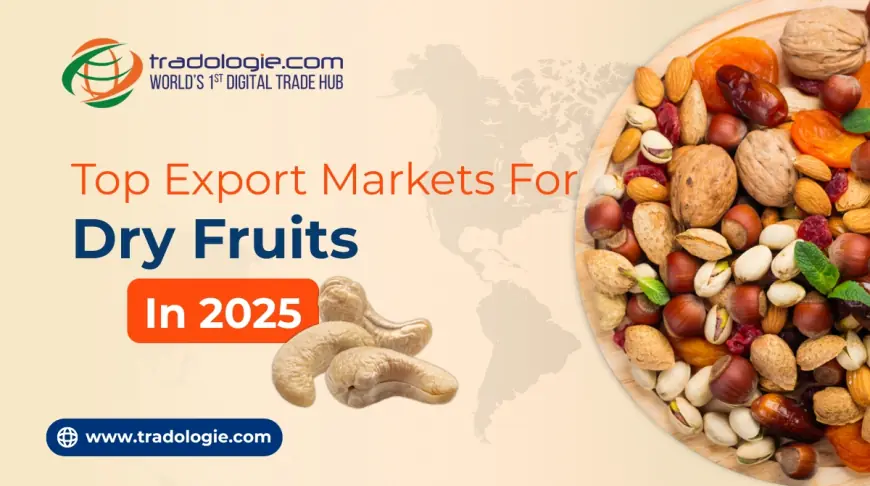Exploring Buyer Trends in Dry Fruits Import Across Middle East Markets
Let’s explore the factors influencing the trend of Middle East buyers in Dry Fruits.

Middle East countries have been driving the trajectory of dry fruit imports in the region, and several factors are contributing to this trend. From Saudi Arabia to the UAE, these oil-rich economies have been seeing a significant increase in people’s disposable income.
Thus, they are shifting their focus from quantity to quality and have caught up with the trend of being extra health-conscious.
Let’s explore the factors influencing the trend of Middle East buyers in Dry Fruits.
Factors Impacting the Middle East Buyers' Trend in Dry Fruits
Cultural Factor (Festival Peaks)
Festivals such as Ramadan, Eid, and Diwali increase the demand for dry fruits in the Middle East countries. In order to secure their consignment’s delivery on time, buyers from the Middle East place their bulk dry fruit order in advance, a few months.
Facts in numbers:
-
During Ramadan, dry fruit consumption in the Middle East increases by approximately 40%, with dates alone accounting for a 25% spike in imports (Source: Food and Agriculture Organization, 2023).
-
Saudi Arabia and UAE see a 30% increase in dry fruit orders placed 2-3 months before Ramadan to ensure timely delivery (Source: Tridge Market Insights, 2024).
Rise in Health Consciousness
As the trend of rise in health consciousness is becoming vastly popular in developing nations, demand for dry fruits in the Middle East has also been going upward in its trajectory.
Fact in numbers:
-
The demand for organic dried fruits in the UAE and Saudi Arabia has grown by 15% annually, driven by consumer awareness of health benefits such as high fiber and antioxidant content (Source: Euromonitor International, 2024).
Increase in Disposable Income
Middle East developing nations, especially UAE members, have been witnessing a significant shift in their citizens’ disposable income, which means an upward trend. This is leading to a major shift in dry fruits imports as well in these countries, where buyers are more concerned about their health than ever before.
Facts in numbers:
-
Disposable income in the UAE rose by 8.2% from 2020 to 2023, contributing to a 12% increase in premium dry fruit imports (Source: Statista, 2024).
-
In Saudi Arabia, per capita spending on health-focused food products, including dry fruits, increased by 10% between 2021 and 2023 (Source: Mordor Intelligence, 2024).
Buyers' Trend in Dry Fruit Import in the Middle East
Quality over Quantity
With the increase in disposable income amongst the Middle East countries, especially the UAE, people are focusing more on quality dry fruits while importing bulk orders.
Research-based fact:
-
Importers in the UAE prioritize organic certifications and clean-label products, with 65% of dry fruit imports in 2023 being premium or organic varieties, compared to 45% in 2018 (Source: Global Trade Insights, 2024).
B2B Tech Enable Sourcing
With the rise in Agro-Tech, B2B traders, be it importers or exporters, have been more reliant on online B2B platforms, facilitating a more secure form of trade-related processing.
Research-based fact:
-
Over 50% of dry fruit importers in the Middle East now use B2B platforms like Alibaba and Tridge for sourcing, with a 20% increase in digital trade transactions recorded in 2023 (Source: International Trade Centre, 2024).
Key Importers in the Middle East
Key importers of dry fruits in the Middle East include Saudi Arabia, UAE, Israel, Egypt, and Kuwait. Saudi Arabia, for example, is known for importing huge bulk orders of Dates and other important dry fruits.
Research-based fact:
-
Saudi Arabia imported 180,000 metric tons of dates in 2023, making it the largest importer of dates in the region, followed by the UAE with 120,000 metric tons (Source: USDA Foreign Agricultural Service, 2024).
Major Exporters to the Middle East
Among key exporters of dry fruits to the Middle East region are some of the dominant forces from the segment, such as Turkey, the United States, Saudi Arabia, Iran, Chile, and several others.
Research-based fact:
-
Turkey accounted for 35% of the Middle East’s raisin imports and 28% of apricot imports in 2023, while the U.S. led in almond exports with a 40% market share (Source: Trade Map, 2024).
Importer’s Challenges
High Costs:
-
Import duties and freight charges increase the cost of dried fruits by 15-20%, impacting affordability for price-sensitive consumers (Source: World Bank Trade Report, 2024).
-
The cost of freeze-dried fruits, popular for their nutritional retention, is 30% higher than traditionally dried fruits, limiting market penetration (Source: FoodNavigator, 2024).
Regulatory Hurdles:
-
Stringent food safety regulations, particularly in the UAE and Israel, require compliance with mycotoxin and pesticide residue limits, delaying import processes by up to 20% (Source: Codex Alimentarius, 2023).
-
Certification requirements for organic products add a 10-15% cost premium for exporters, affecting supply chains (Source: Global Organic Trade Guide, 2024).
Supply Fluctuations:
-
Seasonal variations and climatic challenges in key exporting countries like Turkey and Iran lead to a 10-15% fluctuation in dry fruit supply annually (Source: FAO Agricultural Outlook, 2024).
-
Droughts in 2023 reduced apricot yields in Turkey by 12%, impacting export availability to the Middle East (Source: USDA, 2024).
Market Size and Its Trends
Market Size Trends:
-
The Middle East and Africa dried fruits market was valued at USD 733.47 million in 2023 and is projected to reach USD 1,097.45 million by 2032, growing at a CAGR of 4.54% (Source: Market Research Future, 2024).
-
The global dried fruits market, with significant Middle Eastern demand, was valued at USD 12.02 billion in 2024 and is expected to reach USD 16.55 billion by 2030 at a CAGR of 5.6% (Source: Grand View Research, 2024).
-
The Middle East accounts for 35% of global dried fruit consumption, driven by cultural preferences and rising health awareness (Source: Euromonitor International, 2024).
Impact on Imports:
-
The growing demand for premium and organic dried fruits has increased import volumes by 18% from 2020 to 2023, particularly in the UAE and Saudi Arabia (Source: Tridge, 2024).
-
E-commerce platforms have boosted import accessibility, with online dry fruit sales in the Middle East growing by 25% in 2023 (Source: Statista, 2024).
Conclusion
The dry fruit import market in the Middle East is buzzing with opportunity, driven by growing disposable incomes, a focus on healthier lifestyles, and the deep cultural importance of products like dates, almonds, and pistachios.
Major players like Saudi Arabia and the UAE are at the forefront, seeking top-quality, organic, and premium dry fruits. Thanks to top streamlined B2B agro-platforms and the modern retail channels, businesses are connecting more efficiently than ever.
Despite challenges like high costs, regulatory hurdles, and supply chain inconsistencies, the market is set to exceed USD 1 billion by 2032. Importers can thrive by offering certified, premium products, innovative packaging, and leveraging e-commerce to meet health-conscious and cultural demands.

What's Your Reaction?
 Like
0
Like
0
 Dislike
0
Dislike
0
 Love
0
Love
0
 Funny
0
Funny
0
 Angry
0
Angry
0
 Sad
0
Sad
0
 Wow
0
Wow
0


















































